A story about Kakure Kirisitan (Hidden Christian)
Hello, everyone. I hope You are well and living in peace.
This month, I would like to tell you a story about Kakure Kirisitan, that means, Hidden Christian.
In July 1549, Francisco de Xavier landed Kagoshima, the south end of Kyushu
Island. This Spanish man was a Catholic priest who founded The Society
of Jesus. The first seed of Christianity was thus planted in Japan.
First, the time's authority, Oda Nobunaga and the succeeding Toyotomi Hideyoshi
were not hostile to Christianity, because they liked to know the new world
beyond the sea.
Even some Daimyos (lords) converted their religion from Buddhism to Catholic.
But with the time passing, many foreign priests came in, and struggles
started. Some European countries wanted to make this small but Golden island
their own territory.
In 1587 Toyotomi Hideyoshi tried to exile the priests out of Japan. Still
some Daimyos stayed Christian.
One daimyo returned to Buddhism, and one rejected to abandon Christianity.He
abandoned his territory instead and left Japan forever.
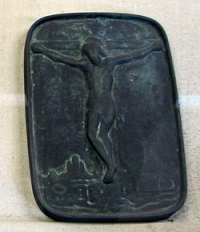 |
The Image of Jesus
This plate was used to find out secret Christians by making them step on
the image. |
At this moment the persecution against people had not yet started.
Then a riot happened in Shimabara and Amakusa in Nagasaki district.
It was not for the religion itself, Poor farmers wanted to survive from
a severe taxation. But because the rioters were mostly Christians, t
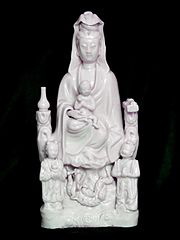 |
| Virgin Mary in Disguise of Bodhisattva |
he Edo Bakufu (Government) issued the persecution order of Christians.
Christians were searched out, and were tortured until they swore to abandon
the belief. Some did not abandon and died as martyrs.
Kakure Kirisitan is a word that means a person/persons who went underground and kept their religion secretly.
They made statues of Mary in disguise of Buddhism Bodhisattva.
There were so many martyrs mainly in Nagasaki. Small villages alongside
the small bays of northern Nagasaki, many good souls were killed in unimaginably
terrible methods. Even in this region of Karatsu, away from Nagasaki, a
history of Kakure Kirisitan existed. Madarashima Island is the place where
Kakure Kirisitans lived in Edo Period. The descendents still live here. |
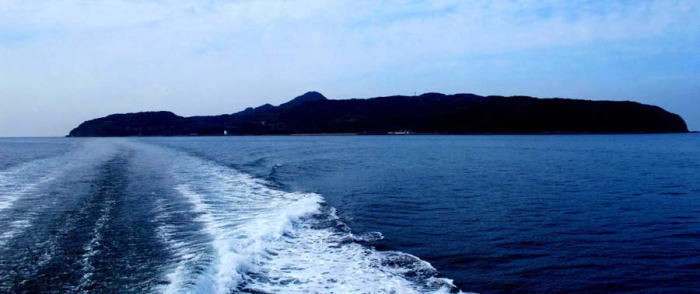 |
| Madarashima, belonging to Karatsu city, is 45 minutes off shore from Yobuko
Port. |
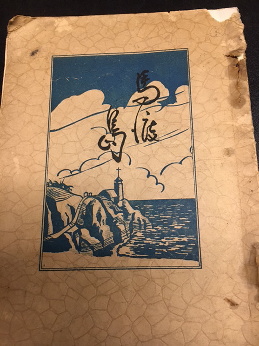 |
Madarashima history book,
published in 1935. |
An history book of 80 years ago tells us the story of Kakure Kirisitan
on this island.
About 400 years ago, a family escaped from persecution in Nagasaki, and came to this island. Ariemon and his family, all 7 members including 3 children. One after another, poor peasants or fishermen set sail in the darkness to this Madarashima Island which belonged to the Lord of Karatsu.
They kept their religion secretly to the original island people, making
a village on the other side of the island.
Probably because this island was far from Nagasaki, and because priests
did not hide here, there was no severe investigation nor arresting, nor
torturing.
There were sometimes testings of Fumie (stepping on the image of Jesus,
to find out who hesitates or rejects to do so), but it seems that the officers
of Karatsu were somewhat generous to Christianity. They might be idle,
too. They did not want to do anything hard.
Edo Bakufu closed its 300 years' history in 1867, and the reign was returned
to the Emperor.
Emperor Meiji, 6 years later, permitted of the freedom of religion.
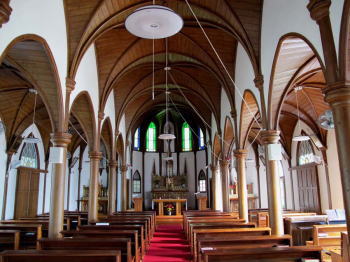 |
| Madarashima Catholic church |
The long persecution was ended at this moment.
Kakure Kirisitans came out into the sun, and they built churches by themselves.
In the middle of Meiji Era, a priest came to this island, and he removed
a church from Nagasaki and rebuilt it here. I can imagine how happy were
the island Christians praying in this solemn church. Even though Madarashima
is only 45 minutes' boat ride, for me who has a terrible sea-sickness ,this
island is much farther than a place of two hours' car drive.
So, in June, I went to Saikai City in Nagasaki Prefecture.
In Saikai City, I visited 3 spots related to old Christianity.
Please enjoy my photo journal.
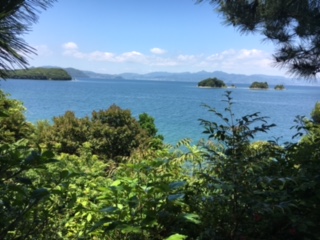 |
Koboshiura Bay in Saikai City.
Here, 2 Christians, Thomas and his son Domingo (Christian names) died as
martyrs on June 17, 1624.
|
In 1965, a bronze panel was discovered from a construction site, and it told the story of the death of Thomas and Domingo.It was written in Spanish.
Closely investigated, the panel was proved to be a true historical information,
and the ushes buried together with the panel came to this place of their
death. A monument was built 346years later, on the same day of their death,
and their ashes are in this monument now. This is the first case of the
discovery of the remains of martyrs. |
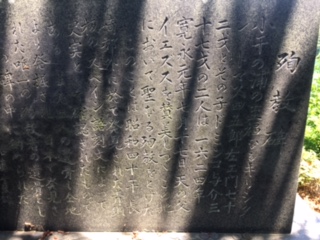 |
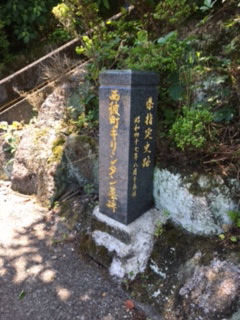 |
This sign shows there is a graveyard for a Christian of the old time.
I climbed up all the stairs to see and pray. |
This tombstone was made before the persecution started. So, proudly,
the Cross (called Flower Cross) and the 4 Initials of I.N.R.I.(Iesus Nazarenus
Rex Iudaeorum) are carved.
This person did not meet the persecution. I do not know what happened to
his family when Christianity was prohibited.
Did they convert? Or did they go underground? Anyway, this stone remained.
Isn't it a blessing?
|
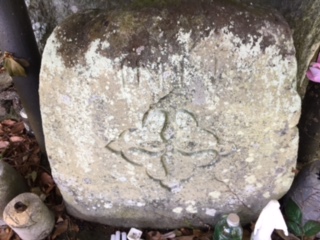 |
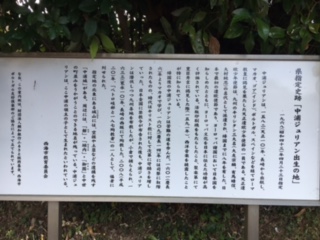 |
We visited the birthplace of Nakaura Julian.
Julian was the son of Nakaura Jingoro, who was the lord of the land at
that time.
In 1579, Alessandro Vallignano was sent to Japan. He was a Jesuit priest. He met some important Christian Daimyos, and he felt the necessity of educate Japanese young men to be Catholic priests. He opened some schools, and one of them was in Arima, present Shimabara of Nagasaki.
In this Seminario, Jingo Nakaura,later Julian,studied with sons of Christian
Daimyos.
.Nakaura Julian (1567? 1568?-1633) |
Vallignano planned an embassy to Europe and Rome by young boys from this
Seminario.
It is the first Japanese Mission to Europe. It was at Tensho Era, so it is called the Tensho Embassy.
Julian was selected as one of the 4 ambassadors of this embassy. He was
15 years old, and was the oldest of 4.
They left Nagasaki on February 20, 1582. After a long , dangerous voyage,
they arrived at Europe. They visited some countries, were warmly welcomed,
and learned many things, like printing art, western music.
There are some wall-paintings in the Nakaura Julian Memorial Hall in Saikai city.
The right painting is one of them and this scene is Vallignano and children
at Seminario in Nagasaki.
|
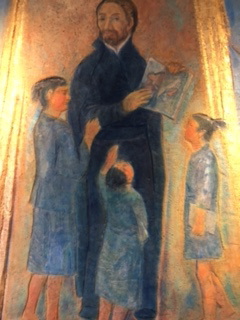 |
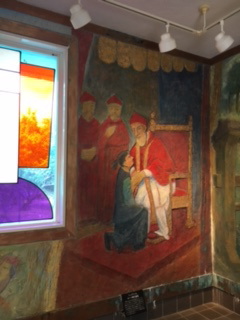 |
Also one of the paintings.
Pope Gregory XIII with Julian.
When the Embassy arrived at Rome, Julian was sick from a contagious disease.
Julian was not allowed to meet Pope, but he insisted that if Pope kindly
meets him, he would surely be cured. Pope met him and blessed him.
Soon after this, Pope himself died. In his death bed, pope was anxious
about the boy from Japan.
Julian was cured, and could go on his mission.
8 years later, the Embassy returned to Nagasaki, on July 21, 1590. Next
year, they met Shogun Hideyoshi,
and played western music for him. Hideyoshi wanted them to be his followers,
but they declined his request.
They went into the monastery in Amakusa, opened by Vallignano, and after that Julian went to Macao to study in the college of Jesuit.
In 1608, Julian became a priest.
|
In 1613, the persecution of Christians was started.
Believers went underground. also the priests, Foreign or Japanese, hid
themselves and went round the underground churches to do their duty as
priests. Julian heard the news and secretly came back to Nagasaki to help
the poor believers.
20 years passed. and in 1632, Julian was arrested in Kokura, Kyushu. He was sent to Nagasaki, to receive tortures to abandon Christianity.
He was hung upside down in a deep hole.
Officers tried to persuade him, but the last words he said to them were,
"I am Reverend Julian who went to Rome."
On the 4th day of torturing, Julian left this world as a martyr. He was
65 years old.
Some other priests and believers died together. Only one priest, who was
on the highest position, abandoned.
Probably because to stop any more sacrifices of the innocent believers.
|
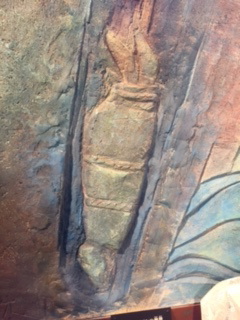 |
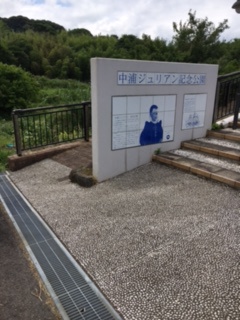 |
Nakaura Julian Memorial Hall is on the Sunset Road (route 202) in
Saikai City, Nagasaki Prefecture. Saikai City faces the sea, and the sunset
there is glorious. |
Nakaura Julian Monument
Sail with Cross, round part is the earth, with the routes of Julian, to
Europe and to Macao. |
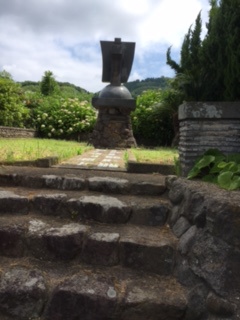 |
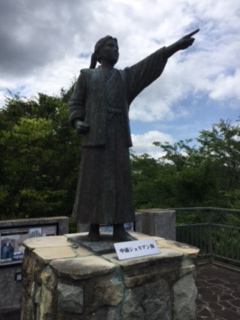 |
On the roof of the hall, there stands a monument of the young Julian.
He is pointing Rome, or Paraiso (paradise)?. |
Just before the rainy season, I visited this place.
Nagasaki prefecture is famous for loquats, and hydrangea flowers.
Here, I saw both.
I picked one fruit of ripe loquats, and put it on the monument.
Let the dew wet the throat of the Martyr, I prayed. |
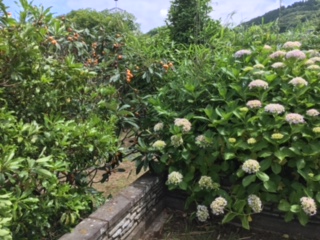 |
I am not a Catholic myself. But graduating from a college founded by the
Society of Jesus, I knew priests and believers. A novel by Endo Shusaku
titled "The Silence" is a story of a foreign priest, who was
arrested and tortured.
I was 20 years old when this book was published. Since then, this novel
has long been my "home work". I thought I s
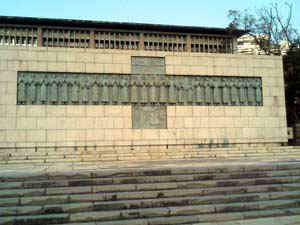 |
26 Martyrs Monument in Nagasaki
The Martyrdom was in 1597. |
hould study more someday.I know that there is coming a new version movie
of this novel directed by Martin Scorsese . I will see it, when it comes
to Japan. Maybe soon.
On November 24, 2008, 375 years after Martyrdom, Nakaura Julian was benefitted
by Pope Benedict 16th.
I saw a letter, written by Julian in Portuguese some years before hid death,
to a high priest in Rome, thanking Pope and making an oath to maintain
his belief however cruel the persecution would be.
The handwriting, though I can not read Portuguese, was so beautiful.
This short trip to Nagasaki will be a most memorable trip in my life.
There still are more places to see to finish my "home work",
in Nagasaki and other districts. Will you go with me?
Thank you for your patience and understanding.
I wish you Peace and Love!
|
Thank you for your company.
See you next month.
Mail to Harumi
Okochi |
|
|
|
|
|